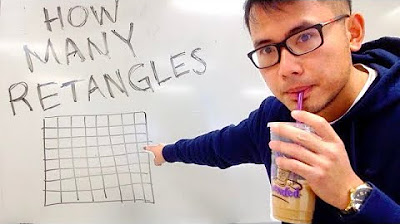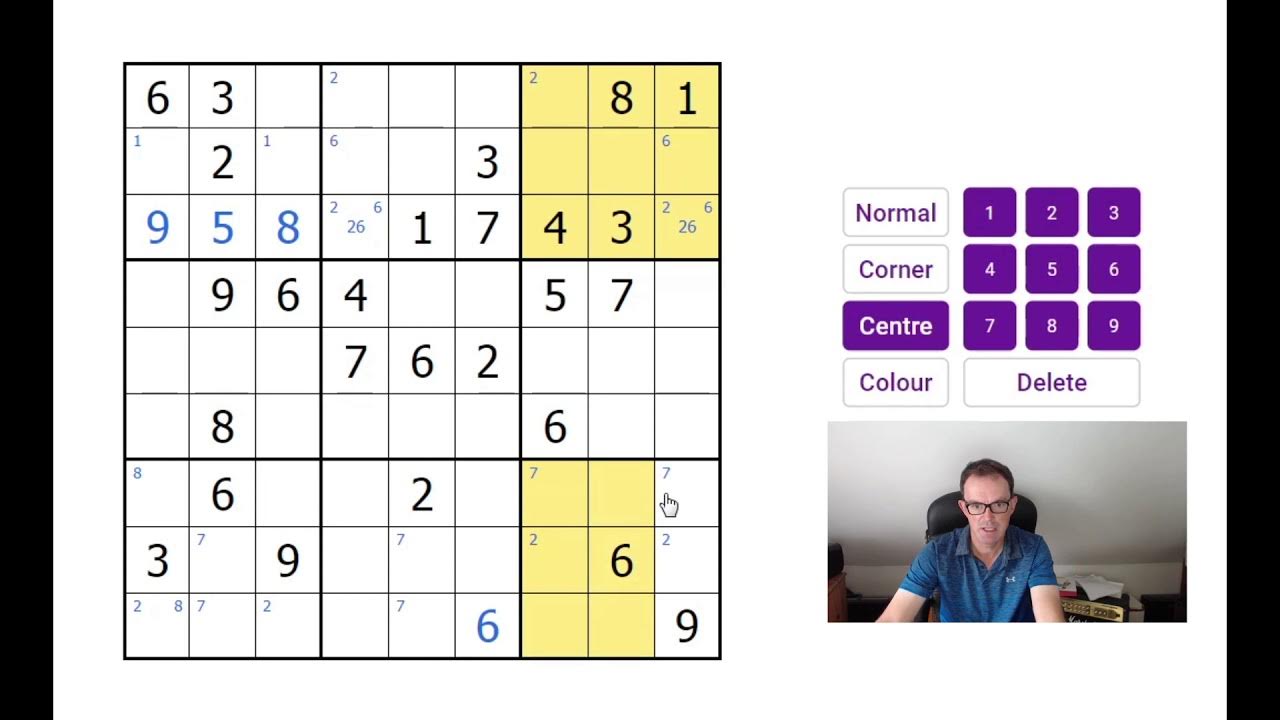Solving 15x15 Nonogram Puzzles
TLDRThe video script provides a step-by-step guide on solving a 15 by 15 nanogram puzzle. The presenter emphasizes the importance of focusing on numbers greater than half the grid's width, which in this case is eight or more. They use various strategies, such as counting across the grid and using placeholders (X) to deduce the placement of black squares. The presenter also highlights the significance of working on the edges first, as it provides a solid foundation for the rest of the puzzle. They demonstrate techniques for determining the sequence of numbers and filling in the grid, including counting across from both sides of a number and using symmetry to ensure accuracy. The script is a comprehensive guide for those new to nanograms or looking to improve their puzzle-solving skills.
Takeaways
- 🔢 Start by looking for numbers greater than half the grid size (in this case, 8 or more in a 15x15 grid) to find clues.
- 🎯 Focus on the edges first, as they provide a solid starting point and can help fill in the rest of the grid.
- 📍 Use placeholders (like an 'X') to mark the starting point of a sequence and then count across to find the pattern.
- 🚫 Remember to remove placeholders after you've used them to avoid confusion.
- 🔁 Count both left to right and right to left to fill in the sequence and identify the pattern.
- 🔄 Look for symmetry in the grid, as numbers that are standalone or in pairs can help determine the placement of other numbers.
- 🔐 If a number is by itself, fill in the spaces around it, as there cannot be spaces between the same numbers.
- 🔄 Use the counting trick to confirm the placement of numbers by counting across and down from the starting point.
- ⛓ Chain numbers together by looking at the top and bottom numbers to determine what must be filled in between.
- 🔍 Look for patterns where numbers cannot fit and mark those spaces as 'X' to eliminate possibilities.
- 🧩 Piece together the grid by using the process of elimination and the clues provided by larger numbers and their placement.
Q & A
What is the first thing the speaker does when solving a 15 by 15 nanogram?
-The speaker first looks for numbers that are more than half of the distance across the grid, which means any number eight or larger.
Why does the speaker focus on the edges first when solving the puzzle?
-The speaker focuses on the edges first because they provide a lot of clues and can help in solving the puzzle more efficiently.
What is the trick the speaker uses when encountering a small number followed by a big number?
-The speaker pretends to place a black square and an 'X', then treats the rest as if trying to fit the big number, which helps in filling in the black squares.
How does the speaker use the number nine in the solving process?
-The speaker uses the number nine by counting across from both sides of the grid and filling in the squares between the two counts, which helps in determining the placement of the black squares.
What does the speaker mean by 'getting rid of the X'?
-The 'X' is used as a temporary marker to help visualize the placement of numbers. Once the speaker has filled in the necessary black squares, they remove the 'X' as it is no longer needed.
How does the speaker approach solving the puzzle when there's a number that's all by itself?
-If a number is all by itself, the speaker fills in all the spaces between the black squares, ensuring there are no spaces between the numbers.
What is the significance of the number seven in the speaker's strategy?
-The speaker uses the number seven as a reference point because, when added to two, it equals nine. This helps in creating a symmetrical pattern in the puzzle.
null
-null
How does the speaker determine the placement of the number four in the puzzle?
-The speaker uses the number four by identifying where it can fit without breaking the pattern and ensuring that it is not more than half of the available spaces.
What technique does the speaker use to solve the puzzle when encountering the number five?
-The speaker counts across five from both sides of the 'X' and fills in the squares between the counts, using this to deduce the placement of black squares.
How does the speaker use the number two in the solving process?
-The speaker uses the number two by counting across and filling in the spaces accordingly, ensuring that the pattern of black squares and blanks is maintained.
What does the speaker suggest as a general strategy for solving a 15 by 15 nanogram?
-The speaker suggests looking for numbers that are eight or larger, using the edges of the grid as a starting point, and employing various tricks to fill in the black squares based on the counts and patterns.
Outlines
🧩 Starting the 15x15 Nanogram Puzzle
The speaker begins by advising viewers unfamiliar with nanograms to watch previous videos on solving smaller ones. They then share their strategy for a 15x15 grid, focusing on numbers greater than half the grid's width (8 or more) to find clues. The process involves counting across and from both sides of these numbers to deduce which squares must be filled. The speaker also emphasizes the importance of starting from the edges and using small and large numbers as markers to find patterns and fill in the grid.
🔍 Using Edges and Numbers to Fill in the Grid
The speaker continues their method by focusing on the edges of the grid, using small and large numbers to deduce the placement of black squares. They describe a trick involving counting from both sides of a chosen number and using placeholders (X's) to mark potential spots. The process includes counting up from the bottom and down from the top to ensure the correct number of squares are filled between markers. The speaker also discusses how to handle situations where numbers force certain squares to be empty due to spatial constraints.
🔢 Applying Strategies to Deduce Number Placement
The speaker elaborates on their technique for solving the puzzle, emphasizing the importance of not having spaces between certain numbers and filling in the required number of black squares based on the count. They use the concept of symmetry to ensure the correct placement of numbers and explain how to adjust the strategy based on the presence of lone numbers or groups of numbers. The speaker also demonstrates how to use the relationships between numbers to fill in the grid progressively, removing placeholders as they go.
🚀 Progressing Through the Puzzle with Clues
The speaker continues to work through the puzzle, using the top numbers and the clues provided by the arrangement of black squares to deduce where other numbers must go. They highlight the process of counting spaces and using the presence of certain numbers to infer the impossibility of others in specific locations. The speaker also explains how to use the numbers at the top of the grid to guide the placement of numbers in the rows below, ensuring consistency and accuracy in the puzzle-solving process.
🎉 Completing the 15x15 Nanogram Puzzle
The speaker concludes their puzzle-solving demonstration by filling in the remaining unknowns and verifying the completion of the 15x15 nanogram. They recap the importance of looking for numbers eight or larger, using edges, and applying various tricks to fill in the grid. The speaker expresses their enjoyment of nanograms and hopes that the detailed walkthrough has been helpful for viewers learning to solve these types of puzzles. They end by confirming the puzzle's completion through a 'done' click and a congratulatory message.
Mindmap
Keywords
💡Nanogram
💡Clues
💡Grid
💡Black Squares
💡Edges
💡Half of the Distance Across
💡Placeholder
💡Symmetry
💡Counting Technique
💡Solving Process
💡Congratulations
Highlights
When solving a 15 by 15 nanogram, start by looking for numbers that are more than half the distance across the grid, which is 8 or larger.
Use the presence of a '9' to deduce that certain squares must be filled in based on counting from both sides of the grid.
Focus on the edges first, as they provide a lot of clues for solving the puzzle.
If there's a small number followed by a large one, place a marker and treat the rest as if you're trying to fit the large number.
Remember to remove the marker (X) after using it to denote a potential placement.
Knowing an edge allows you to deduce the pattern of black squares and blanks that follow.
Use symmetry to ensure that if you have two white spaces on one side, there should be two on the other.
If a number is by itself, fill in all the spaces between known black squares.
When you have a number that cannot be larger than a certain value, discount all higher numbers to find potential black squares.
Count across from both sides of a known number to fill in the squares between as either black or blank.
Use the presence of large numbers like '7' and '1' to deduce the placement of spaces and black squares.
If a number cannot fit in a certain space due to the count of squares, it must go elsewhere.
Look for patterns where a number is all by itself, indicating that the spaces around it must be filled.
Utilize the top numbers to determine the sequence of black squares and blanks in a row.
When a number is repeated in a row or column, use that to deduce the placement of other numbers.
Keep looking for clues and work methodically until the puzzle is solved.
The process involves a lot of counting, pattern recognition, and strategic placement of markers and blanks.
Always double-check your work by scanning through the entire grid to ensure all placements are correct.
The speaker expresses a love for nanograms and hopes the explanation helps others learn to solve them.
Transcripts
Browse More Related Video

Math for fun, how many rectangles?

How to Solve a Word Search Puzzle Quickly - Tips, Tricks and Strategies - Step by Step Instructions

How To Do Hard Sudokus In 10 Minutes

Create a Word Search puzzle in Canva - (easy tutorial)

Make Your Own Crossword Puzzle in Microsoft PowerPoint

The Sudoku Trick All Expert Solvers Know
5.0 / 5 (0 votes)
Thanks for rating: